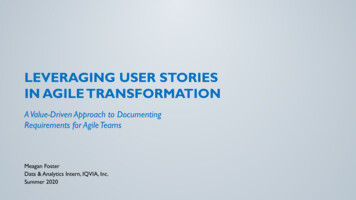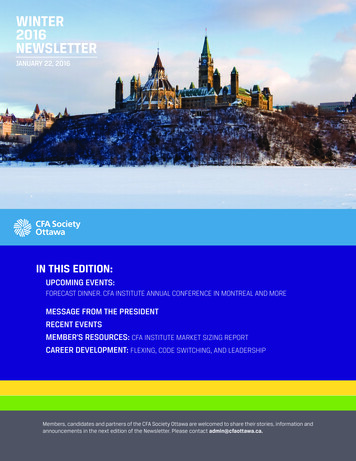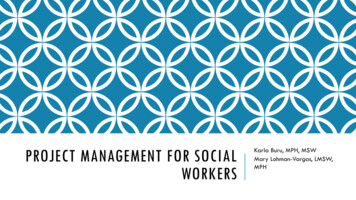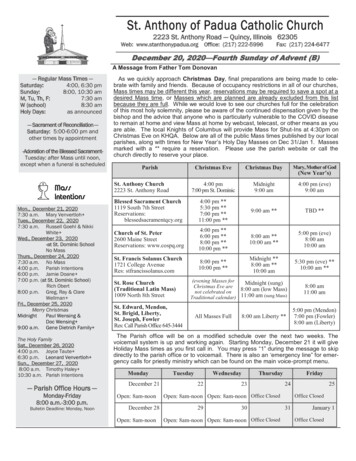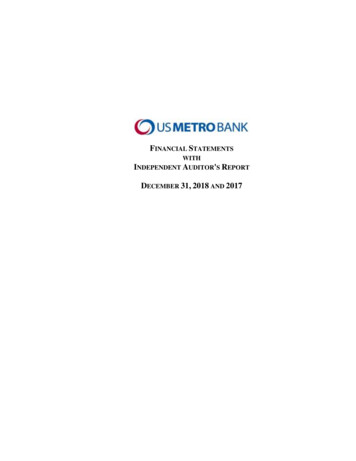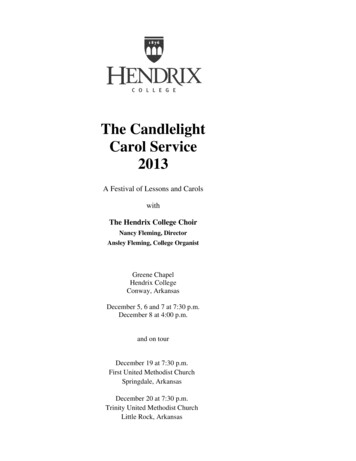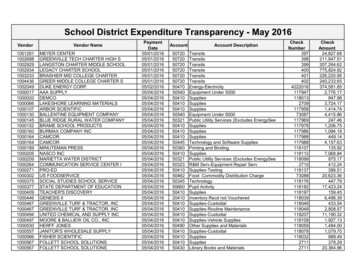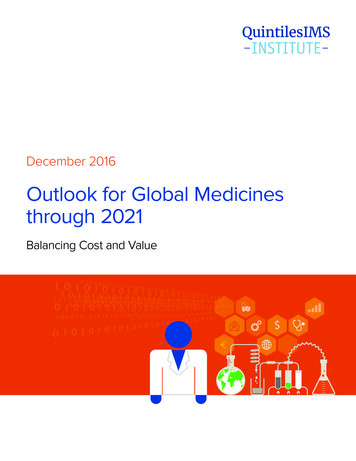
Transcription
December 2016Outlook for Global Medicinesthrough 2021Balancing Cost and Value
IntroductionMedicines are advancing at an astonishing rate, as are the challenges in funding access to them forcountries around the world faced with slowing economic growth and limited resources. Each part ofthe world is facing these challenges and addressing them differently.In this report, we provide an outlook on the use of medicines and spending levels through 2021.Over the next five years, we expect to see a historically large number and quality of new medicinesemerge from the research and development pipeline. In addition, we expect that issues of pricing,access and priorities will come to the forefront like never before.This study was produced independently by the QuintilesIMS Institute as a public service and withoutindustry or government funding. The contributions to this report of Sarah Rickwood, Paul Duke,Bernie Gardocki, the QuintilesIMS forecasting team and many others at QuintilesIMS are gratefullyacknowledged.Murray AitkenExecutive DirectorQuintilesIMS InstituteQuintilesIMS Institute100 IMS Drive, Parsippany, NJ 07054, nstitute.org 2016 QuintilesIMS and its affiliates. All reproduction rights, quotations, broadcasting, publications reserved. No part of this publication may be reproduced or transmittedin any form or by any means, electronic or mechanical, including photocopy, recording, or any information storage and retrieval system, without express written consent ofQuintilesIMS and the QuintilesIMS Institute.
Contents0 1 Executive summary05 By the numbers05 Global medicine use and drivers of growth07 Comparison of key countries and regions1 1 Rising specialty medicine use14 Transformations in disease treatments1314New medicines available in 2021New drug classes that will transform care30 Trends in U.S. medicines30 Spending and growth to 202132 Pricing and patient out-of-pocket costs34 Loss of exclusivity and biosimilars 39 Pricing and growth in Europe39 Spending and growth to 202140 Impact of Brexit41 Controlling healthcare spending44 Medicine use in pharmerging markets44 Spending and volume growth to 202146 Derailed commitments and expansion programs505 15253Notes on sourcesReferencesAuthorsAbout the QuintilesIMS InstituteOutlook for Global Medicines through 2021. Report by the QuintilesIMS Institute
Executive summaryThe total volume of medicines consumed globally will increase by about 3% annually through2021, only modestly faster than population and demographic shifts, but driven by very differentfactors around the world. Spending on medicines will grow by 4–7%, primarily driven by newermedicines in developed markets and increased volume in pharmerging markets. Developedmarkets will offset increased costs from new medicines with the use of generics, and a greaterfocus on pricing and access measures, while pharmerging markets will struggle to live up topromised access expansions made when their economic outlooks were stronger.By the numbersGlobal medicine spending will reach nearly 1.5 trillion by 2021 on an invoice price basis, up nearly 370 billion from the 2016 estimated spending level. Importantly for the outlook is that spendinggrowth is slowing in 2016, declining from nearly 9% growth in 2014 and 2015 to just 4–7% CAGR overthe next five years. The short-term rise in growth in 2014 and 2015 was driven by new medicinesin hepatitis and cancer that contributed strongly to growth but will have a reduced impact through2021. Most global spending growth, particularly in developed markets, will be driven by oncology,autoimmune and diabetes treatments where significant innovations are expected. The U.S. willcontinue as the world’s largest pharmaceutical market and pharmerging markets will make up 9 ofthe top 20 markets. China will continue as the #2 market, a rank it has held since 2012. Developedmarket spending growth will be driven by original brands, while pharmerging markets will continueto be fueled by non-original products that make up an average 91% of pharmerging market volumeand 78% of spending. New medicines increasingly are specialty in nature, and their share of globalspending will continue to rise from less than 20% ten years ago to 30% in 2016 and to 35% by 2021,approaching half of total spending in U.S. and European markets. This rise primarily will be driven bythe adoption of new breakthrough medicines, but also will be a key focus of payers and constrainedby cost and access controls as well as a greater focus on assessments of value. Off-invoicediscounts and rebates, particularly in the U.S. market, will reduce invoice-price growth by about 1%,resulting in a total global market of 1 trillion in 2021.Transformations in disease treatmentThe number of new medicines reaching patients will be historically large with 2,240 drugs in thelate-stage pipeline and an expected 45 new active substances (NAS) forecast to be launchedon average per year through 2021. The new medicines will address significant unmet needs incancer, autoimmune diseases, diseases of the metabolism, nervous system and others. In additionto the continued research of mechanisms in use in existing drugs, there will be an ongoing flowof new mechanisms to target cell processes and diseases across the spectrum. Developmentsthat go beyond specific “drugs” are emerging in research that will challenge traditional regulatory1 Outlook for Global Medicines through 2021. Report by the QuintilesIMS Institute
EXECUTIVE SUMMARYapproval and commercialization approaches. These include completely new platforms that will seetheir first human uses in areas such as gene-editing technology CRISPR, which could transformpersonalized cancer treatments while creating a plethora of ethical dilemmas. Advances areexpected to treat a range of diseases by harnessing the microbiome (a person’s own gut bacteria),as well as regenerative cell technologies that include stem cells harvested from one part of the bodyto use against a disease in another.Cancer is by far the largest general category of research, including immunology, cell-therapyand dozens of molecularly targeted agents. Treatment choices will be made based on the tumordiagnosis as much as by a patient’s family history, genetic marker or by biomarkers the tumorexpresses. The sheer number of cancer treatments, their potential combinations in treatmentregimens, and the variety of companies involved in development will bring significant change tothe landscape of cancer treatment over the next five years. Dramatic improvements in survival andtolerability are expected and will be accompanied by substantially greater levels of clinical trial andreal-world information to support treatment decisions. Payers and providers are developing toolsto better assess value and will demand, or create on their own, the evidence to support spending,especially where new treatments would add to already expensive cancer treatment costs.Trends in U.S. medicinesU.S. market growth will slow by half in 2016 to 6–7% from 12% in 2015, and is forecast to average6–9% through 2021. This decline is a key driver of the overall global slowdown and has similarcauses—the end of Hepatitis C-driven growth and the greater impact of patent expiries after a periodwith fewer brand losses of exclusivity. U.S. growth also was lifted in 2014 and 2015 by historicallyhigh price increases for both brands and generics on an invoice-price basis before the impact ofoff-invoice discounts and rebates. After adjusting for those price concessions by manufacturers,spending growth is estimated to be more than 4 percentage points lower in 2016 and 2 percentagepoints lower through 2021, growing at a 4–7% CAGR. Pricing, and particularly the difference betweeninvoice and net prices, will be a key political issue for the incoming administration but is unlikely toaffect the forecast net growth rates.Medicine costs will be driven by the use of transformative specialty brands and invoice priceincreases, offset by rebates and the use of lower-cost generics. Brand prices will increase at8–11%—more slowly than the 12–15% in the past 3 years, and with fewer outlier major price increasesas these have become unsustainable in light of high-profile media and political attention. Net pricesfor protected brands are expected to increase, albeit at a slower 2–5% rate, and including somedeclines for products facing greater competition and price transparency.Patient out-of-pocket costs are forecast to decline despite rising brand prescription costs as patientsshift to newly available generics and receive copay assistance for brands. More than one-third ofprescriptions will have no out-of-pocket costs. Free prescriptions are a growing trend as somepatients receive preventive services under the Affordable Care Act, under expanded eligibility forMedicaid, and through some insurance plans.2 Outlook for Global Medicines through 2021. Report by the QuintilesIMS Institute
EXECUTIVE SUMMARYThe reduction in overall spending as branded medicines lose exclusivity is expected to total 143.5billion in the next five years—more than 1.5 times the impact as in the past five years. This includes theestimated impact of biosimilars, which will contribute between 27–58 billion, uncertainty based onmultiple issues in litigation with originators, as well as regulatory, pricing and competitive dynamics.Regardless of the uncertainty, biosimilars are expected to affect spending over the next five years, with25–35 products in development across biologic molecules with the highest sales levels.Pricing and growth in EuropeLow pre-rebate and discount growth of 1–4% in the EU5 countries through 2021 is partly drivenby policymaker responses to unexpectedly high new drug spending growth in 2014 and 2015,and efforts to control future growth. The Hepatitis C drugs were surprising to stakeholders in theireffectiveness, the extent to which patients and providers were willing to use them, and the budgetimpact that few were able to accurately predict. Looking forward, these budgeting weaknessesare prompting European payers to redouble their efforts to bring predictability to their budgetingprocesses for drugs—especially given the wave of promising agents to treat a variety of diseases.Mechanisms that control access based on clinical quality alone may not be sufficient in the face ofthe variety and number of breakthroughs expected.Perhaps the most pressing question for European governments on issues outside pharma centeraround BREXIT. The more than half-century of progressively greater integration of Europe includingmedicines-related institutions and practices will make disentangling the U.K. from Europe extremelycomplicated, not least because the U.K. government has yet to officially trigger the process. Whileuncertainties remain, the impact on the U.K. pharmaceutical market is expected to be modest witha 1.5% slower growth rate in the downside scenario, than the basecase outlook for 4–7% growth to2021, still the highest medicine spending growth in the EU5 in either case.Relatively weak economic growth in the region, combined with budget concerns arising fromadopting and paying for recent innovations, will encourage European payers to be more cautiousin adopting newer medicines in the future. Mechanisms to control price and/or access to innovativedrugs continue to be the main tools used by European governments to manage spending onmedicines, and will limit spending growth through the forecast period. As a result, fewer newlaunches in Europe are achieving price premiums, as few medicines are considered breakthroughswhile the remainder are subject to more stringent levels of price limitations at launch.Medicine use in pharmerging marketsSince 2011, the global expansion in the volume of medicines used essentially has been driven bypharmerging markets, where volume grew 37.5% over five years, or 7% annually, compared with 2%in total over five years in all other markets.3 Outlook for Global Medicines through 2021. Report by the QuintilesIMS Institute
EXECUTIVE SUMMARYIn most developed markets, where access already was high and usage driven by demographic shiftsto aging populations, volume grew an average of 0.4%—less than half the rate of population growthin most markets. In pharmerging markets a decade ago, many lacked basic healthcare infrastructureand patients often paid for medicines out-of-pocket without insurance coverage. As accessexpanded through government support of expanded infrastructure and either government or privateinsurance coverage, medicine usage expanded broadly. More recently, as economic growth hasslowed, medicine volume growth also has slowed, showing a direct correlation between medicineusage and affordability.Compared to ten years ago with the start of their growth boom, leading pharmerging markets haveseen real GDP growth slow from 1 to 4 percentage points, and their currencies’ value to the U.S.dollar weaken by 15–35%. Medicine spending growth has slowed from 2–10 percentage points overthe past five years in major pharmerging markets and is expected to slow further. Volume growthaveraged 7% for pharmerging markets over the past five years but is expected to slow to 4% through2021, as China declines from 17% average annual volume growth in the past five years to 4% CAGRin the five years through 2021. Broad economic issues have led to a range of derailed commitmentsand delayed, revamped or cancelled expansion programs—initiatives that may be hard to restarteven if economic conditions recover.Overall, volume growth continues to be driven by non-original products that account for 91% ofvolume in pharmerging markets, and the outlook for spending growth across these markets isexpected to be slower in the next five years and beyond.4 Outlook for Global Medicines through 2021. Report by the QuintilesIMS Institute
By the numbers Global medicine spending will reach nearly 1.5 trillion by 2021 O ncology, autoimmune and diabetes treatments will drive much of the growth D eveloped market spending growth will be driven by original brands while pharmergingmarkets will continue to be driven by non-original products I nnovation in specialty medicines will continue lifting the share of global spending from 30%in 2016 to 35% in 2021 S pecialty medicines will approach half of medicine spending in the U.S. and EU5, drivenby the adoption of new breakthrough medicines and constrained by cost and accesscontrols and a greater focus on assessments of value G lobal spending growth will be driven by branded products in developed markets, offsetby the impact of patent expiries and off-invoice discounts and rebates, particularly in theU.S. marketG rowth will slow from nearly 9% in 2014 and 2015 to 4–7% over the next five yearsH epatitis C treatments which drove 2–3% points of growth in 2014 and 2015 will have areduced impact to 2021T he U.S. will continue as the world’s largest pharmaceutical market and pharmergingmarkets will make up 9 of the top 20 markets with China as #2Global medicine use and drivers of growthGlobal spending on medicines will reach nearly 1.5 trillion in 2021 growing at 4–7 %—only slightly slower than the 5.9%growth over the past five years, but with growth expected to be more uniform and predictable in nature (see Exhibit1). The last five years included two of the most unusual events in the history of the industry—the so-called “patent cliff”and the launch in quick succession of effective cures for Hepatitis C (Sovaldi and Harvoni), which became the two mostsuccessful new medicine launches of all time. The next five years will see the market growing at a more consistent ratebut with much more attention focused on spending, growth and specifically pricing (see Exhibit 1).Notable in 2014 and 2015 were not only the Hepatitis C launches, which captured global attention, but also the significantcurrency fluctuations for major global currencies against the U.S. dollar. Global pharmaceutical spending grew by 8.8% in2015 on a constant U.S. dollar basis, which removes the impact of currency exchange rates, equivalent to 85.7 billion.Exchange rate effects reduced that growth to 7.4 billion (see Exhibit 1).5 Outlook for Global Medicines through 2021. Report by the QuintilesIMS Institute
BY THE NUMBERSThe continued growth of global medicine spending over the past decade and the next five years will more than doublethe amount spent on medicines over that fifteen year period. Over that timeframe the drivers of medicine spending andgrowth have shifted from the blockbuster drugs of the late 1990’s, to the volume-driven growth in pharmerging marketsand the developed markets patent cliff, and over the next five years to a continued boom in innovation-driven spendinggrowth for breakthrough immunology treatments across a range of diseases.Exhibit 1: Global Market Spending and Growth 2007–20211,60010%9%1,400Spending US Bn7%1,0006%8005%4%6003%4002%200Growth Consistqnt US ng2015201620172018201920202021GrowthSource: IMS Market Prognosis, Sep2016; QuintilesIMS Institute, Oct 2016Key therapy areas driving spending and growth over the next five years will be led by oncology, reaching 120–135billion in spending in major developed and pharmerging markets (see Exhibit 2). Oncology spending will grow at 9–12%,largely similar to the last five years, driven by continued wave of immune-oncology treatments with dramatically improvedoutcomes and tolerability for patients.Diabetes treatments continue to evolve with new more convenient formulations, combinations and delivery systemsexpected in the next five years as well as the wider adoption of biosimilars in major developed markets. The combinationof continued innovation, disease prevalence and biosimilars will see diabetes spending reach 95–110 billon by 2021,up an average 8–11% over the next five years.Biologic treatments for autoimmune diseases, including treatments for rheumatoid arthritis, psoriasis, ulcerative colitis,Crohn’s disease and a range of related disorders continue to see increasing usage across geographies and will reach 75–90 billion in spending by 2021, up 11–14%. There are a range of new treatments in development which will stretchthe definition of autoimmune diseases to include additional dermatological, gastrointestinal and pain related conditions.In addition, biosimilar products—those approved as similar to an originator reference biologic product—will be availablefor several of the leading autoimmune products by 2021, potentially allowing wider use of these medicines with the sameor lower overall spending.6 Outlook for Global Medicines through 2021. Report by the QuintilesIMS Institute
BY THE NUMBERSExhibit 2: Outlook of Leading Therapy Areas Spending and Growth, Constant US 702–5%Antibiotics and Vaccines54.42.5%60–702–5%Mental 6–9%Antivirals 7%All OthersSource: IMS Therapy Prognosis, Sept 2016; QuintilesIMS Institute, Oct 2016Note: Includes 8 developed and 6 pharmerging countries: U.S., EU5, Japan, Canada, China, Brazil Russia, India, Turkey, MexicoComparison of key countries and regionsThe U.S. is the leading global market, growing at 6.9% over the past five years and expected to grow by 6–9% over thenext five years. China has broadly kept pace with U.S. market growth while no other global market has done so (seeExhibit 3). China became the number two global market in 2012, passing Japan which had been the number two marketsince 1975 when we began measuring medicine spending in our publication World Review . China continued to grow atdouble-digit growth rates until 2015 when it slowed to 5.6% following a series of price cuts. China is expected to grow ata more modest 5–8% rate to 2021 when it will reach 140–170 billion (see Exhibit 4).Generally over the past decade and forecast for the next five years, developed markets have gradually slid downthe rankings of country spending as pharmerging markets have risen. Considering the vastly larger populations inpharmerging markets, where 4 of the world’s 7 billion people live, this growth also brings attention to the remaininginequality in access to healthcare globally.The ten developed markets including U.S., Japan, Germany, U.K. Italy, France, Spain, Canada, South Korea and Australiarepresent a diverse range of health systems from the way in which they are funded, controlled and their expectationsof spending and growth. Japan and France have a range of growth expected from a 1% decline to 2% growth, each withsignificant government focus on the price, associated volumes and overall spending of innovative medicines. WhereasJapan retrospectively cuts prices every two years—and more sharply if a medicine is more widely used than forecast—France attempts to control spending with reimbursement controls at launch, based on clinical quality assessments, andacross-the-board caps on spending which result in paybacks to the government in the case of overspend.7 Outlook for Global Medicines through 2021. Report by the QuintilesIMS Institute
BY THE NUMBERSOther developed markets represent generally less aggressive or direct measures in controlling drug spend and asa result will see modestly higher spending growth through 2021. The group of ten developed countries will grow onaverage by 4–7% to 2021 and represent 67% of global spending in that year—that share down slightly from 68% in 2016.Exhibit 3: Top 20 Countries Ranking Constant US 1South South Korea212131India3132South 61Mexico2179Argentina2171Poland1171Saudi Arabia1183Netherlands2186Saudi na1203Switzerland220Switzerland120Egypt1Source: IMS Market Prognosis, Oct 20167Change in ranking over prior five yearsAppendix notes: Rankings based on Constant US . Argentina based on US with variable exchange rates due to hyperinflation.Index reflects comparison to the U.S. of spending in Constant US .Ten years ago we first defined pharmerging markets as low income countries with high pharmaceutical growth, set to emergeas strong investment opportunities for multinationals as well as being social development success stories in their own right. Atthat time there were seven countries which met our criteria (China, Brazil, Russia, India, South Korea, Mexico and Turkey).8 Outlook for Global Medicines through 2021. Report by the QuintilesIMS Institute
BY THE NUMBERSOver the past decade that number has grown to 21, and some countries like South Korea have notably “emerged” asdeveloped markets, while others have appeared only for a limited time as long-term growth prospects and sustainabledevelopment have remained elusive. Notable for their economic and political challenges in recent years, Ukraine, Venezuela,Romania and Thailand were once counted as pharmerging markets but while they still have per capita incomes below 30,000 on a purchase price parity basis, their economic weakness will prevent them from funding the pharmaceuticalspending growth of 1 billion over the next five years that would result in their inclusion as pharmerging. The latest updateof our definition also includes four new countries (Bangladesh, Chile, Kazakhstan and the Philippines) each of which will facetheir own economic challenges to sustain healthcare investments that over time will provide wider coverage for millions oftheir people as well as spur more investment and focus from innovators to the diseases their populations face.Exhibit 4: Key Region and Country Spending and Growth to 20212016US BnGlobal2011–2016 CAGRConstant US 2021US Bn2016–2021 CAGRConstant US 5%South ��1705–8%Tier –6%DevelopedPharmergingTier 3Rest of WorldSource: IMS Market Prognosis, Oct 20169 Outlook for Global Medicines through 2021. Report by the QuintilesIMS Institute
BY THE NUMBERSThe types of medicines available, and chosen by people around the world are substantially different, with 78% ofpharmerging markets spending on products other than the original from the inventors or marketers of a medicine,compared to 69% of developed market spending going to those originators (see Exhibit 5). Developed markets havehistorically provided and supported patent protection for originators, and followed patent expiry with rapid and significanterosion of those medicines to replace their usage with generics. The development of approval pathways for biosimilarsover the past decade along with patent expiries for both small molecules and biologics will offset branded growth andcontribute to slower growth in developed markets over the next five years.Pharmerging markets have only begun to more fully support intellectual property rights in the last decade, and moststill retain a significant legacy of use of non-original medicines. The use of these medicines ranges from copy products,to branded non-original products, to over-the-counter medicines (OTC), to a range of traditional Chinese, Indian andJapanese medicines that compete with biopharmaceutical medicines in some markets.Exhibit 5: Spending and Growth by Region and Product TypeSpending 2021 US Original BrandsNon-OriginalBrandsUnbrandedOther ProductsTotalUS BnGlobal56%22%12%10% 1,455–1,485BnDeveloped69%14%12%5% 975–1,005BnPharmerging22%42%14%22% 315–345BnRest of World51%27%8%14% 130–160Bn2017–2021 CAGRConstant US Original BrandsNon-OriginalBrandsUnbrandedOther ng4–7%7–10%8–11%5–8%6–9%Rest of World2–5%4–7%3–6%3–6%3–6%Source: IMS Market Prognosis, Sept 2016; QuintilesIMS Institute, Oct 2016Notes: Spending Share point values for guidance, Growth estimates /– 1.5%; Other Products includes OTC products and other non-categorized productsGlobal medicine spending and growth will be driven by divergent patterns over the next five years. Developed markets willbalance a substantial surge in spending on new medicines with cost controls, a focus on pricing and transparency acrossmarkets and the impact of patent expiries at 170 billion (1/3rd greater than in the last five years). Pharmerging markets willgrow more slowly in dollar terms than in the last five years as China (the largest market and largest growth driver) slowsto 5–8% growth from an average 12.4% in the last five years. Pharmerging countries have widely varying economic, socialand healthcare environments and while they share a common theme of being driven by lower-cost non-original medicines,they retain significant variations in the mechanisms with which they fund, manage and oversee healthcare and medicines.10 Outlook for Global Medicines through 2021. Report by the QuintilesIMS Institute
BY THE NUMBERSRising specialty medicine useInnovation in specialty medicines will continue to lift the share of global spending from 30% in 2016 to 35% in 2021driven by the adoption of new breakthrough medicines. While specialty medicines will continue to increase in sharein developed markets, and approach half of medicine spending in the U.S. and EU5, in pharmerging markets specialtymedicines will continue with lower share of 5–20% of total medicines spending (see Exhibit 6). Growth of specialtymedicines will be constrained by cost and access controls and a greater focus on assessments of value.Exhibit 6: Specialty Medicines Share of Spending 2007–2021 Constant US nceOther major developedItalySpainAustraliaCanadaJapanSouth thersChinaBrazilRussiaIndiaOther PharmergingSource: QuintilesIMS Institute, Oct 2016In addition to geographic and product-type diversity, countries also demonstrate significant heterogeneity in the waysmedicines are priced. Some countries directly manage the price of medicines, negotiating directly with manufacturersat launch, controlling price increases (if any are allowed) and mandating rebates as well as periodic price cuts. Others,like the U.S., devolve price negotiations to markets, and allow and even encourage confidential discounts and rebates,which enable market participants to manage drug costs, but also mask the true nature of medicine spending and pricenegotiation from observers and the general public. In this report, we continue our efforts to estimate the net spendingon medicines to provide some greater transparency and understanding of the underlying trends. We have undertakenthese estimates using public sources as w
11 Rising specialty medicine use 14 Transformations in disease treatments 13 New medicines available in 2021 14 New drug classes that will transform care 30 Trends in U.S. medicines 30 Spending and growth to 2021 32 Pricing and patient out-of-pocket costs 34 Loss of exclusivity and biosimilars

